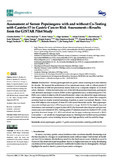Assessment of serum pepsinogens with and without co-Testing with gastrin-17 in gastric cancer risk assessment—results from the GISTAR pilot study

Ver / Descargar
Fecha
2022-07-19Autor(es)
Robles, ClaudiaRudzite, Dace
Polaka, Inese
Sjomina, Olga
Tzivian, Lilian
Kikuste, Ilze
Tolmanis, Ivars
Vanags, Aigars
Isajevs, Sergejs
Liepniece-Karele, Inta
Razuka-Ebela, Danute
Parshutin, Sergej
Murillo, Raul
Herrero, Rolando
Park, Jin Young
Leja, Marcis
Autor(es) Corporativo(s)
Pontificia Universidad Javeriana. Facultad de Medicina. Departamento de Medicina Interna. Grupo de Oncología. Centro Javeriano de Oncología
Tipo
Artículo de revista
ISSN
2075-4418
COAR
Artículo de revistaCompartir este registro
Citación
Documentos PDF
Abstract
Introduction––Serum pepsinogen tests for gastric cancer screening have been debated for decades. We assessed the performance of two pepsinogen assays with or without gastrin-17 for the detection of different precancerous lesions alone or as a composite endpoint in a Latvian cohort. Methods––Within the intervention arm of the GISTAR population-based study, participants with abnormal pepsinogen values by ELISA or latex-agglutination tests, or abnormal gastrin-17 by ELISA and a subset of subjects with all normal biomarker values were referred for upper endoscopy with biopsies. Performance of biomarkers, corrected by verification bias, to detect five composite outcomes based on atrophy, intestinal metaplasia, dysplasia or cancer was explored. Results––Data from 1045 subjects were analysed, of those 273 with normal biomarker results. Both pepsinogen assays showed high specificity (>93%) but poor sensitivity (range: 18.4–31.1%) that slightly improved when lesions were restricted to corpus location (40.5%) but decreased when dysplasia and prevalent cancer cases were included (23.8%). Adding gastrin-17 detection, sensitivity reached 33–45% while specificity decreased (range: 61.1–62%) and referral rate for upper endoscopy increased to 38.6%. Conclusions––Low sensitivity of pepsinogen assays is a limiting factor for their use in population-based primary gastric cancer screening, however their high specificity could be useful for triage.
Cobertura espacial
LetoniaCobertura temporal
2013-2015Enlace al recurso
https://www.mdpi.com/2075-4418/12/7/1746Fuente
Diagnostics; Volumen 12 Número 2 , Páginas 1 - 11 (2022)
Estadísticas Google Analytics
Colecciones
- Artículos [13]

